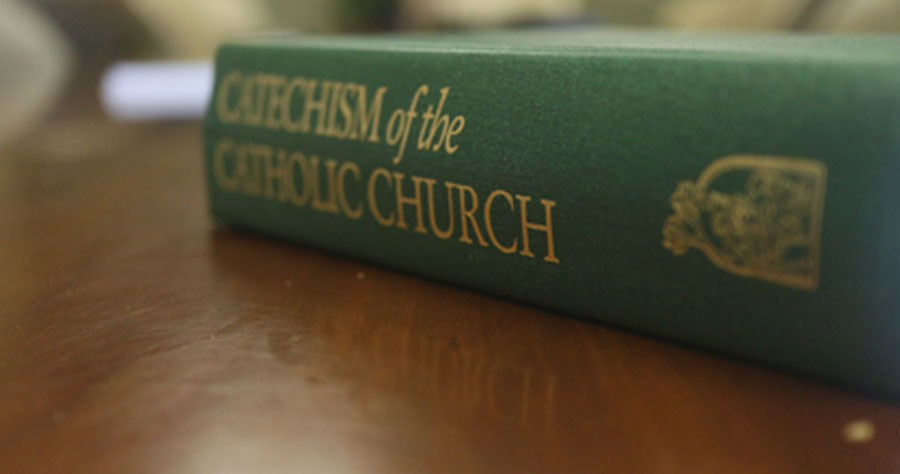Catholic harmony
The Oxford Dictionary of Music informs us that while the term “symphony” has varied in meaning over the centuries, “as the word is now generally used, it means a large-scale orchestral composition […] reserved by composers for their most weighty and profound orchestral thoughts.” October 11, 2017 sees the twenty-fifth anniversary of the promulgation of the Catechism of the Catholic Church [CCC] which St John Paul II presented to the Church as a document which “truly expresses what could be called the ‘symphony’ of the faith”. As the most comprehensive and richest explanation of the Catholic faith ever written, it is an immense gift to the Church and to the world.
The Dictionary of Music points out that the word “symphony” comes from the Greek, meaning “a sounding together”. The harmonious interplay of scripture, the Fathers, liturgy, magisterium and saints in the CCC is truly symphonic. The text is enriched by all the liturgical and spiritual traditions of the Church and framed in the teaching of the Second Vatican Council with its apostolic thrust to proclaim the fullness of the Faith anew to one and all. It is in fact the catechism of the Council.
St John Paul II saw the CCC as faithfully echoing “the symphony of the Faith” because it contains “the harmony of so many voices”. In fact the process of the formation of the Catechism engaged the entire Church in a truly catholic and collegial way. All the world’s bishops and Catholic universities were consulted. There were 938 replies, offering over 24,000 suggestions. These suggestions were examined, evaluated and included in the text where possible.
Organic unity, in four parts
A symphony is normally in four movements the Dictionary of Music tells us. The CCC too has its four “movements”. It adopts the four classical catechetical “pillars” which had previously provided the framework for the Catechism of the Council of Trent (also called the Roman Catechism), the only other major universal catechism produced in the history of the Church.
The four pillars of the Catechism are its four “Parts”, namely: (i) The Profession of Faith (Creed), (ii) The Celebration of the Christian Mystery (Liturgy), (iii) Life in Christ (Morality), and (iv) Christian Prayer. It is an organic movement from lex credendi to lex celebrandi, to lex vivendi, to lex orandi. Part One teaches the articles of the Creed; Part Two how we celebrate these mysteries in the liturgy; Part Three, how this faith known and celebrated is lived in daily life, and Part Four, how we nourish this faith by prayer as individuals and as members of the communion of the Church. As Cardinal Gerhard Müller has pointed out: “The Catechism essentially represents a statement of Catholic culture expressed in the same structure as the New Testament statement of the culture of the early Church – ‘And they devoted themselves to the Apostles’ teaching and fellowship, to the breaking of bread and the prayers’ (Acts 2:42)”.
The CCC is outstanding for its organic presentation of the Catholic Faith. Like a good symphony, each part is essential and enriches the others and all together they reveal the one central drama being expressed. As some experts in the teaching of the CCC have put it, “the Catechism has given us the opportunity to understand the wholeness of the Faith once more”.
In music the symphony genre is “reserved by composers for their most weighty and profound orchestral thoughts.” It is not just a “weighty and profound thought” that forms the organic unity of the CCC, but rather the one saving Word, Jesus Christ. The CCC is a magnificent symphony of Christ, the Beauty of all beauties, bringing together many voices and scales, instruments and rhythms, orchestrated in the unity of the believing Church. The words of Cardinal Christoph Schönborn apply perfectly to the CCC of which he was the general editor: “Catechesis is not so much an exercise in teaching topics, but rather an orderly and systematic initiation into the revelation that God has given of himself to humanity in Christ”.
The Christocentrism of the CCC is reflected in its logo. This is an image taken from a Christian tombstone in the catacombs of Domitilla in Rome dating from the end of the third century. It depicts Christ, the Good Shepherd who leads and protects his faithful (the lamb) by his authority (the staff), draws them by the melodious symphony of the truth (the panpipes) and makes them lie down in the shade of the tree of life, his redeeming Cross which opens paradise.
The Food of Love
The Preface to the CCC concludes with words from the Preface to the Catechism of the Council of Trent: “The whole concern of doctrine and its teaching must be directed to the love that never ends. Whether something is proposed for belief, for hope or for action, the love of our Lord must always be made accessible, so that anyone can see that all the works of perfect Christian virtue spring from love and have no other objective than to arrive at love”. For his part, the Bard said: “If music be the food of love, play on”. The CCC is a unique and powerful instrument for the universal evangelization to which the Holy Father is calling us particularly at this time. The music of this unsurpassed symphony, the Gospel of Joy, is to be savoured and shared starting form this text.
Recent years have seen an exciting new initiative for studying the CCC gather momentum all over Ireland. Adult Studies of the Catechism of the Catholic Church offers the chance to study the CCC locally along with a group of other interested people. For more information see: www.catechism.ie.
About the Author: Rev. Donncha Ó hAodha
Rev. Donncha Ó hAodha is a priest of the Opus Dei Prelature, author of several CTS booklets and a regular contributor to Position Papers.

